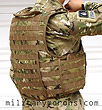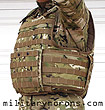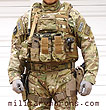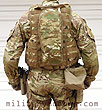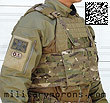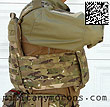Armour and Protective Equipment Page 1 Page 2 Page 3 Page 4
TO VIEW FULL SIZE IMAGES: USERNAME and PASSWORD are both "mm"
BattleLab R.B.V. Predator
Ballistic Vest (2nd Gen)
9/22/08 - Diamondback Tactical has updated their BattleLab line of tactical nylon for 2008-2009, which includes a complete re-design of their tactical vests, like the BattleLab Advanced Warrior F.A.P.C., reviewed previously. Shown here is the R.B.V. Predator ballistic vest, 2nd Gen, which incorporates these upgrades and new features. The Predator is essentially the non-cutaway version of the Praetorian
Rapid Cutaway Ballistic Vest, which is designed for over-water operations.
The Predator is for users who do not have a need for the cutaway feature.
It is designed to meet the operators' need for a versatile, modular
tactical vest with increased load-carry capacity, mobility, speed and
ease of adjustability. It is currently being fielded in the govt, LE
and military arena.
Overall Description - The Predator is available in small, medium (shown here), medium/long, large, XL and XXL sizes with plate pockets to fit the plates of corresponding size. Colours available are Army UCP digital, coyote borwn, ranger green, black and Crye MultiCam (shown here). The user has the option of a couple of three different Level 3A armour ballistic insert packages; the Predator is not available without ballistics. The Predator is compatible with BattleLab's Armoured Warrior Accessories, which include additional ballistic protection and pockets/pouches. The Predator is constructed mainly of 1000D cordura with 500D cordura used in some areas for weight/thickness savings where abrasion is not a concern.
|
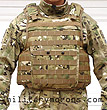 Predator front |
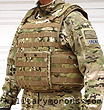 |
 Side |
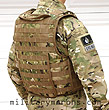 |
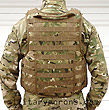 Rear |
Note that the detailed descriptions that follow apply to the medium size Predator. Other sizes might have additional (or fewer) molle webbing rows or columns. Front Panel (outside) - The front panel of the Predator is shaped to match the SPEAR/BALCS cut front ballistic insert. The side flaps wrap around the torso towards the rear of the body, providing ballistic protection for the sides. There are 3 rows x 4 columns of PALS webbing on the side flaps/extensions. I personally wouldn't have a need to mount pouches there, as they'd add a lot of bulk under the cummerbund, but I've been told that some people will store flat, small items there, like a pair of medical shears or light sticks. Either way, nothing bulkier than a low profile pouch is very practical there - mount larger items to the external cummerbund instead. There are 3 rows x 8 columns of PALS/MOLLE webbing on the upper chest; of which the top row is loop velcro for IR squares, name tape etc. In the center is the front pocket/cummerbund flap. It has 4 rows x 6 columns of PALS on it, and flips up to expose the loop velcro panel for securing the ends of the external cummerbunds. Two tabs with snaps at each of the bottom corners provide additional security to lock the flap down over the cummerbund ends. Behind the PALS webbing is a full size low profile bellows pocket which folds flat, closed at the top with velcro and two snaps. It's designed to be used with the BattleLab Accessory Platform Pouches. It's shown in the photo below with the Utility Zipper Pouch conversion kit, which converts the front pocket into a utility pouch with zipper top. It's stiffened/reinforced with HDPE so that the opening is semi-rigid. I find this accessory very versatile, as you can store items inside the pocket, and this is the lowest profile method of carrying three 30-round M4 mags for replenishing the outer pouches if needed. Front panel (inside) - The inside of the front panel is lined with open mesh fabric, which covers reticulated foam padding/spacer mesh material. This provides a small standoff distance and a higher level of comfort above that of plain cordura by allowing some breathing space between the inside of the panels and the body. The reticulated foam will not hold water or sweat, and is quick drying. A single row of PALS webbing on the abdomen provides a means of attaching a Ballistic Groin Protector. Inside the front, just below the neck line is loop velcro for attaching an optional ballistic yoke to protect the front of the neck. Hook velcro on the side panel extensions mate with the loop velcro on the rear panel. A velcro-closed ballistic insert/plate compartment is accessed near the bottom inside of the panel. The bottom of the panel is constructed out of 500D cordura and has three drainage grommets. More on the ballistic panels and plate pockets later.
Rear Panel (outside) - The rear panel is shaped similarly to the front panel, but with a higher collar and shorter side extensions. At the top of the rear panel are the shoulder pads, which extend from the top of the panel, go over the shoulders and connect to the front panel. A heavily reinforced drag handle constructed out of 2" wide webbing is sewn to the top of the panel. There are 4 rows x 8 columns of PALS webbing on the upper half of the rear panel. In the center of the panel is a flap, which covers the cummerbund attachment compartment and flips up to expose it for access. The flap is secured with velcro, and has 5 rows x 6 columns of PALS webbing. On either side of the center flap are the side extensions which wrap around the back of the torso towards the front. They meet the front panel extensions which overlap them and secure with velcro. The external cummerbunds are inserted into the rear panel through openings on the extensions. There are an additional 4 rows x 3 columns of PALS webbing on the extensions, on either side of the center flap. Rear Panel (inside) - The inside of the rear panel is lined with the same mesh and reticulated foam padding as the front and has the ballistic insert and plate pockets. The inside of the collar has loop velcro to interface with the optional Ballistic Collar. There is a 4"-wide internal cummerbund, with the fixed portion sewn to the left panel extension. The right side of the internal cummerbund is elastic, and attaches at the rear of the panel (more on that below). Shoulders - There shoulder pads extend from the top of the rear panel, over the shoulders and slide into guide loops on the inside front of the front panel. The higher the ride height, the more the pads slide into the front loops. Velcro-secured adjustment straps are attached to the front panel, and are routed through triglide buckles sewn on top of the shoulder pads extending from the rear panel. Tightening the straps and pulling down on them in front make the vest ride higher. The strap ends have pull tabs for easy adjustment, which is best done when wearing the vest. The ends of the straps can actually be tucked into the openings for the straps where they come out of the front panel, out of the way. There are no buckles or hardware on the front of the shoulders to interfere with a rifle butt. The shoulders are lightly padded and lined with Drilex for comfort. They can accomodate Level 3A shoulder armour inserts.
|
 Rear panel |
 Inside of rear panel showing cummerbunds |
 Internal cummerbund |
 Shoulder adjustment |
 Shoulder details |
Cummerbund attachment and adjustment - The external cummerbunds wrap around the sides of the vest and meet at the front, under the front pocket/flap. As mentioned above, the left internal cummerbund is fixed while the right side is adjustable in girth. Half of the internal cummerbund is elastic while the other is loop-velcro covered nylon. Two 3/4" wide straps are sewn to the end, each with a male side-release buckle. The straps are bartacked every 1", which provide positive stops every 1" in length adjustment. The side release buckles on the straps click into two female buckles sewn down near the middle of the lower back of the vest. This portion is covered by the rear flap. The girth of the internal cummerbund is adjusted at the rear by lengthening or shortening the straps in 1" increments. The external cummerbunds have a similar strap setup, but have three instead of two. The three straps are sewn to a vertical strip is nylon which is in turn attached to a a short length of elastic. The elastic allows the cummerbund to 'give' a bit and provides positive tension on it to keep it tight. Both left and right cummerbunds attach and detach very quickly and are easy to adjust equally, by counting the 1" bartacks on the straps. All the loose strap ends are covered up with the rear flap, so it's not as messy as it looks in the pics. The straps have at least 6" of adjustment, which provides an extra foot of girth if that's ever needed. External cummerbund details - The external cummerbunds have three rows of PALS webbing on the outside. The cummerbunds are stiffened with a plastic insert which support the weight of attached pouches. Inside the cummerbund is a plate/soft armour insert pocket, completely lined with velcro. There are two drainage grommets at the bottom of the pocket. A single row of PALS webbing is sewn at the top, which is carried over from a previous design of a side plate pocket. It still has its uses, though. The front end of the cummerbund is covered in hook velcro on both sides which engages the front velcro area on the vest and the back of the front flap.
|
 External and inner cummerbunds |
 Cummerbund adjustment |
 Inside of external cummerbund |
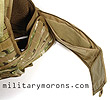 Plate/ballistic insert compartment |
 Front pocket/flap |
 Front flap open |
 Front plate pocket |
 Front panel soft insert pocket |
 Front QVA-3A-1 ballistic insert |
 Rear insert |
 Shoulder armour inserts |
Observations and notes - With the full QVA armour package in place (front and rear ballistic panels, shoulder ballistic inserts), plus front and back ceramic plates, the Predator obviously has some heft to it. However, I felt that the weight was well distributed when I put it on, and 'wears lighter' than it is. The ride height was easy to adjust while wearing it, by shortening or lengthening the shoulder straps. The medium size fit me perfectly. I have a 42" chest and the front panel side extensions overlapped the rear side extensions with about half the velcro panel engagement. So, there's some accomodation for someone slightly thinner or stouter than I with the medium size. I did have an issue with the external cummerbund, though. As it came with the Predator, it was too long for me. I had both sides adjusted as short as they'd go in the back, and they overlapped too much in the front. I brought this up to BattleLab and was told that there was one size of cummerbund offered at that time. However, they were very receptive to the idea that a smaller size might be needed for size small and medium vests, so they made and sent out a set that was two PALS columns shorter than the ones originally supplied with the Predator. These were the perfect length and had more than enough addtional length adjustment. They also had room to be shortened as well. At the time of this writing, BattleLab is working on adding two additional sizes of external cummerbunds to cover the entire size range of Predator vests. I found mobility to be good in the Predator, as far as armoured vests go. The SPEAR/BALCS cut front panel isn't so wide that it prevents me from extending my arms forward when using an isoceles stance/hold. The thickness of the plate, armour and vest combined adds about 1.5" of thickness to the shoulders/chest area, and necessitates me running the M4 carbine with the stock fully collapsed. This is no different than other ballistic vests I've tried and it's just one of the things you have to adapt to when shooting with body armour. Keeping the upper chest and shoulder areas relatively clear of pouches also facilitates getting a rifle shouldered. The small EMDOM baby shingle mounted in the middle of my chest is about as much as I'd want mounted there. The mesh lining and reticulate foam padding on the inside of the front and back panels does make a difference in comfort level. The open cell reticulated foam 'spacer material' is more easily compressed than closed cell foam, but conforms better and the open structure provides airspace (and allows possible airflow) between the body and the main cordura fabric of the vest.
Shown below is the Predator with a minimalist setup - pretty much with water and ammo only for range use (EMDOM USA 3o2 pistol pouch, CQB M4 mag pouches and ITW FAST mag, Crye hydration bladder cover in the back - not available). I kept the sides slick and free of pouches, for better access to my handgun and subload. Obviously, someone with a need to carry more can do so - the Predator can handle it. The improvements and upgrades implemented in the Gen 2 Predator make it a choice worthy of consideration if you're looking for a full-featured ballistic vest.
|
7/2/10 - Over two years in the making, the much anticipated PIG-PC (Patrol Incident Gear) Plate Carrier is finally out; available exclusively from SKD Tactical. The PIG-PC is versatile and modular design with some unique, innovative features not not offered on other plate carriers. It's obvious a lot of thought and attention to detail went into the design of the PIG-PC. Overall Description - The PIG-PC is a lightweight plate carrier system that allows the user to configure it according to their mission profile. It is made by Eagle Industries for P.I.G. and offers some features that aren't found on other products. The PIG-PC has a hybrid construction; it uses 500D cordura and light weight pack nylon in different areas depending on exposure to abrasion, to minimize weight. It has multiple cummerbund options and is the first plate carrier to utilize the ITW G-hook - one of the most versatile pieces of hardware on the market today. The main components of the PIG-PC consist of the 'chassis' (a one-size fits most front plate carrier and a rear plate carrier), and the different choices in cummerbund, plus various accessories. Front Plate Carrier - There are three full rows of velcro-covered PALS webbing (out of five rows, total) in the front, so you can mount pouches or patches alike. The plate carrier is 8 columns across, tapering to 6 rows at the top. Two 1" webbing strap are sewn to the top corners of the carrier, to which buckles are mounted for connecting it to the rear plate carrier via the shoulders. The straps are used to adjust the ride height of the carrier, and either velcro down in front, or can be tucked under the webbing. Instead of a single cummerbund retention flap in front, the PIG-PC has split cummerbund retention flaps, each with 3 rows and 4 columns of PALS webbing. By splitting the cummerbund flaps, the user is able to keep one side attached at all times through repeated don/doff cycles. The flaps' outer corners are retained by snap tabs that come up from underneath to keep the corner retained. Each flap includes a kangaroo pouch for hasty item storage or integration of dedicated flap pouches. The kangaroo pouches are velcro secured, and open with a small tab. The back of the front plate carrier is lined with light weight pack nylon, with an area of loop velcro at the top. PIG is thinking ahead, and the velcro will enable future accessories to be integrated there. |
 Front carrier |
 Inside of front carrier |
 Split flaps |
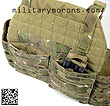 Kangaroo pouch |
Both front and rear PIG-PC plate carriers feature 'elevated plate profile'. Most plate carriers on the market tend to carry the plate extremely low in relation to the most vital organs and vessels in the upper-thoracic region they are meant to protect. One of the main goals of the PIG-PC carrier was to get both front and back plates high enough to maximize protection of the user's vitals. An adjustable plate harness pushes each plate to the top of the plate pocket. It wraps under the plate, engages velcro inside the pocket and has a pull tab if the plate needs to be ditched. The plate compartment is lined with velcro along the upper inside edges. The velcro adheres the front and back panels of the compartment together, and and keep the plates centered left and right. This feature allows the wearer to use any size SAPI plate from Small through Extra Large (or similar corner cut plates) without having the plates bottom out or swim around in the carrier. Note that Extra Large plates might be exposed on the bottom corners. Behind the plate pockets are dedicated plate-backer pockets with velcro closures. Each PIG-PC ships with a custom cut foam panel that sits inside a dedicated pocket to increase comfort for the wearer. This foam insert can be removed and replaced with a soft armor insert without having to touch your plates and visa-versa. This makes plus-ing up or scaling down a much simpler operation. Shown below are the DBT plate backer Level III inserts behind a SAPI plate.
Rear Plate Carrier - The rear plate carrier has the padded shoulders sewn to the inside, placing the top of the rear plate above the connection point to the shoulder straps. This keeps the rear plate as high as possible and allows both front and rear plates to be optimally positioned without sacrificing comfort. Like the front plate carrier, the rear plate carrier has a velcro area at the top with velcro-covered webbing, so both pouches and patches can be attached. There are 6 rows and 8 columns of PALS webbing, with the top two rows being tapered. The bottom 3 rows of webbing are sewn to the outside of the rear pocket/channel, through which the cummerbund passes through and secures to the velcro inside (more on that later). The channel is 6" tall and runs across the bottom of the plate carrier. At the top of the rear plate carrier is a semi-rigid drag handle. The tubular nylon drag handle houses a length of plastic tubing to increase surface area and comfort when gripping. The rounded profile is more comfortable to grip than webbing alone. The rear plate carrier features a rear padding system consisting of two vertical back pads that keep contact off of your spine and creates an air-flow channel to aid in increased ventilation and heat dissipation. These vertical pads flow into the integral padded shoulder straps, creating a continuous shock-absorbing feature that is extremely comfortable for extended use. Shoulders - The shoulder pads are padded for comfort and have loop velcro on the underside for future accessories. 1" webbing is sewn on top of the shoulder pads and tacked down at intervals. This 1" webbing is what the ITW G-hooks attach to. The ITW G-Hook is one of the most versatile pieces of hardware available to the tactical market today. It allows webbing, D-rings, buckles etc. to be attached by hooking onto PALS webbing. It's used for the primary shoulder strap attachment mechanism, which allows the user to replace hardware in the field and select between a side release buckle or a metal D-ring assembly. Shown below is the GH-DD / G-Hook Double D-Ring Kit (2) - This double ring assembly allows the user to replace a G-Hook Side Release Buckle assembly on the PIG-PC Chassis to allow for a reduced profile, and very quick strap adjustment. I replaced the side-release buckle with the double D-ring on my left shoulder, as I only need to open up the carrier on the right side. Each shoulder has two elastic loops for hydration tube or comms wire routing.
|
Multiple Cummerbund Options - The PIG-PC has 2 cummerbund options and 2 side plate carrier options which gives the user 4 different configurations to select from. More cummerbund options will be available in time (like a soft-armoured one). Elastic Cummerbund (PIG-PC-CBE / Elastic Cummerbund) - A simple 4" wide elastic cummerbund attaches via velcro to the rear cummerbund channel on the PIG-PC rear plate carrier. The user affixes the cummerbund at the bottom-most 4 inches of the rear cummerbund channel (which is 6" tall), and in turn secures the front of the cummerbund at the bottom-most 4 inches under the front cummerbund flaps. This is the lowest-profile cummerbund option and is used when no side plates or pouches are needed. The length adjustment is made by varying where the cummerbund ends are velcro'd down in the rear. If need be, they can be overlapped. I adjusted them so that they'd come around all the way at the front and fully engage the velcro under the flap. They also have 550 cord pull loops which aid in getting them unstuck when doffing the carrier. |
 CBE - elastic cummerbund |
 Installed on rear plate carrier |
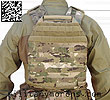 Back view |
 Front attachment |
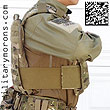
|
 |
 |
PIG-PC-SPC-CBE / Side Plate Carrier for Elastic Cummerbund - For users who want side plate protection, the side plate carrier for the elastic cummerbund is available. A rigid plastic backing keeps the plate from sagging on the elastic cummerbund, and maintains a low-snag slick profile. The carrier holds both 6"x 6" and 6" x 8" plates (note that 6" x 8" plates will stick out of the pocket), and can be moved along the cummerbund for user-optimized placement. The leading edge of the plastic backing should remain oriented to the front, to engage with the front cummerbund flaps, but they can be reversed so that the retention strap is facing down if the user finds it makes the plate placement more comfortable. The small piece of webbing is for the attachment of the PIG-PC-LIK (Load Integration Kit) using G-hooks. |
 Side plate carriers for elastic cummerbund |
 Retention strap |
 Installed on CBE - outside |
 Inside |
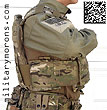 |
PIG-PC-CBM / Molle Cummerbund - With 10 columns and 3 rows of PALS webbing on each side, this cummerbund allows for a host of modular mounting options. The rear ends of the molle cummerbund have elastic, and are attached by elastic shock cord lacing. Adjustments to the shock cord can be made through an adjustment slot in the rear cummerbund channel of the PIG-PC Chassis. The paracord pull handles aide in removal when doffing. The inside of the cummerbund is lined with loop velcro to incorporate the PIG-PC-SPC-CBM (Side Plate Carrier, Molle Cummerbund) with a grommet for a retention tether. I found that I ran out of adjustment - I have a 32" waist and couldn't get the cummerbund tight enough, so I replaced the shock cord lacing with a plastic tie strap, woven through the grommets. It worked very well, and I just make small circumferential adjustments at the front under the split flaps. The molle cummerbund has no stiffener or insert pockets. |
 CBM - molle cummerbund |
 Inside |
 Installed to rear carrier |
 Front attachment |
 Using a tie-strap |
Accessories - Shown below are some of the currently available accessories for the PIG-PC. More are in the works, as the modular design of the PIG-PC lends itself very well to customization. When ordering a PIG-PC system, you select the PIG-PC Chassis and one type of PIG-PC Cummerbund. This Ala Carte system allows the user to custom configure their carrier for their specific mission straight from the vendor. PIG-PC-SPC-CBM / Side Plate Carrier for Molle Cummerbund - This velcro pouch offers the user a side plate capability for the PIG-PC-CBM. Due to the large velcro engagement area inside the cummerbund, the user has a host of placement options, fore and aft, as well as by turning the orientation of the pouch. The pouch will hold both 6"x 6" and 6"x 8" side plates with the retention strap oriented up or down. The cord supplied with each PIG-PC-SPC-CBM is for a tether to be tied through the grommet on the cummerbund for additional retention in extreme environments. PIG-PC-LIK / Load Integration Kit - Utilizing the innovative G-Hook from ITW, this kit includes all the necessary hardware to allow for the seamless integration of load and/or hydration systems such as the popular Eagle YOTE pack. Note that the male SR buckles are not included. PIG-PC-GH-SRB / G-Hook Side Release Buckle Kit (2) - Each PIG-PC-Chassis includes this item as a primary attachment for front and back plate carriers. This kit provides 2 additional assemblies to use as field replacements, or to attach additional accessories to the array of G-Hook anchors on the PIG-PC padded shoulder straps.
Pictured below is the PIG-PC with Molle cummerbund in the two photos on the left, and the side plate carrier for elastic cummerbund in the two photos on the right. I have used the GH-SRB and LIK to attach my EMDOM Vehicle Hydration Carrier. I used male SR buckles that I had on hand to mate it with the female buckles on the LIK and GH-SRB. I'd like to see male buckles included with these kits. SKD has made some informational videos which show how the PIG-PC goes together and how each of the accessories work. It's worth watching them for more information.
Observations and notes - There's a lot to like about the PIG-PC. It's modular, low profile and design has been well thought through. It's very adjustable, and I was able to adjust the height to get the plates as high as possible. I configured the PIG-PC with the GH-DD double d-ring on the left shoulder, and the GH-SRB side release buckle on the right shoulder (since I'm left handed). I didn't want a buckle on my firing shoulder, but needn't have worried as the rifle stock sits on the plate, and doesn't really go near the buckle. Once I had adjusted the ride height of the carriers via the two front straps, I tucked the straps into the molle webbing so they'd be out of the way. Being made of 500D instead of 1000D cordura helps make the PIG-PC one of the lighter plate carriers I've tried. I used a medium CPC triple curve plate in the front and a large SAPI plate in the rear; both with DBT soft plate backers. I left the foam inserts out of the pockets to reduce bulk. They're really for use only when a stand-alone plate is used. One of the issues when shooting with plates is that there's no good place to put the rifle butt. Sometimes it ends up on the corner of the plate, or far off to the side, off the plate. Sometimes I hook the butt behind the plate. With the PIG-PC, since there isn't any built-in padding, the only thing that really adds thickness is the plate and insert. Therefore, it was low profile enough for me to place the butt right on the plate. It also sat high enough to get more of the butt fully on the plate. In the photo below, I have a pistol mag pouch mounted on the left upper side of the front plate carrier with a multi-tool in it. Rather than getting in the way, the pouch acts as a stock catch, and prevents the butt from slipping. The rifle butt is placed just to the inside of the pouch. I shot from a variety of positions and the pouch does not hamper rifle stock placement in any of them; it only helps (me). The PC-PIG is only as tall as the height of the plate, and for a short-torsoed person like me, that's the way I like it. It's designed to ride high, and provides adequate clearance between the bottom and a belt. It reminds me a lot of the Crye Plate Carrier in that respect. I didn't find mobility or range of motion affected by the carrier itself - it's more a function of the pouches attached to it. Another thing I like about it are the split front flaps - I can leave one engaged and lift the other one up for donning and doffing.
|
 |
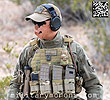 EMDOM-MM IAP mag pouches (protos) |
 EMDOM VHC |
 |
 |
I found the padded shoulders to be as comfortable as to be expected with a relatively light load (4 M4 mags, 2 pistol, small items, EMDOM VCH with 50-oz Source bladder and 2 plates + 2 soft inserts/plate backers), and I attached my EMDOM Universal Rig Strap to the right shoulder pad to support my rifle, instead of a sling. The EMDOM-MM IAP (Immediate Access Pouch) mag pouches are prototypes at the time of this writing, but will be available in the near future. I was originally skeptical that the molle cummerbund would be able to support any weight, since it was unstiffened, but it actually worked well. In the pics, I only have a couple of small pouches mounted on the cummerbunds, but I tested it with larger pouches and heavier items, and as long as tension is maintained in the cummerbund, it's fine (within common sense weight limits, of course). Since it's thin, it presents a very low profile, which I like having on the side. Up-armour capability with soft inserts will be available in the future from PIG. Since the rear of the front plate carrier is pack nylon, and has no mesh or ventilation, it can get a bit hot under there. SKD said that the mesh material is heavier, which is why they went with the pack nylon instead. Granted, I'm not sure how much difference mesh material would make but I'm guessing that on a 'micro' level, mesh can aid in evaporation of sweat. I'd like to see SKD try a version with a mesh backing like the DBT Predator reviewed above, but without any reticulated foam padding (to keep bulk down). (Note, SKD had a mesh-backed front panel made for me and I do find it more 'breathable' and comfortable in hot weather). With all the choices available for the user to customize his PIG-PC according to his needs/mission (with even more accessories and choices to come), the PIG-PC is one of the most versatile plate carriers I've tried at the time of this writing. |
Mayflower R&C APC
(Assault Plate Carrier)
1/10/11 - The APC (Assault Plate Carrier) from Mayflower R&C (Research & Consulting LLC) is a molle-compatible, modular plate carrier that is somehow able to pack a lot of features into a low profile, lightweight package. It has no padding or anything that adds extra bulk, but is surprsingly comfortable to wear. SKD Tactical will be the first dealer to carry it, and will be offering a discount for the first two weeks. Since they first appeared (publicly) on the tactical nylon scene in March 2009, Mayflower R&C has made a name for itself specializing in designing and building tactical nylon with an emphasis on light weight and low bulk. Their philosophy comes from 20 years of Infantry and Special Operations experience and revolves around trimming unnnecessary weight off the load that the military athlete carries to war. This is done usually with the use of lighter weight materials or different manufacturing techiniques without sacrificing durability and function. Overall Description - The APC differs from Mayflower's Low-Profile Armour Carrier and Low-Profile Assault Armour Carrier by the fact that it's designed solely to carry plates (with backers if necessary); instead of plates and soft-armour inserts. This is to provide the user with the lowest profile option while still providing rifle plate protection. The APC is a non-rapid cutaway plate carrier; it's an over-the-head design constructed mainly of 500D solution dyed Cordura for a high strength to weigt ratio. The main components of the APC are a front plate pouch, rear plate pouch, and cummerbunds. There are two sizes of carriers, and three sizes of cummerbunds that make up four sizing options: Size S/M1 (small cummerbund) for waist 34"-44", Size S/M2 (medium cummerbund) for waist 42"-52", Size L/XL3 (medium cummerbund) for waist 43"-53" and Size L/XL4 (large cummerbund) for waist 49"-59". The plate pouches are sized to fit stand-alone or in-conjunction with BALCs/ESAPI or Swimmer cut plates. The two sizes of plate pouches are designed for small/medium SAPI plates or L/XL plates (although the S/M pouch will fit a large SAPI plate). Each size of cummerbund differs by about 3 inches in length; they're all the same height. Front Plate Pouch - The front plate pouch (S/M shown here) has 4 columns of PALS webbing on the upper chest, and a utility slot pocket behind it with four elastic loops. The utility slot pocket is 5" deep with a velcro closure inside, and is intended to be used as an everyday admin pocket for pens, pencils, small notebook, chemlites etc, or as a 'seal and forget it until you need it' pouch where a small cut down orange panel, signal mirror etc can be stored. There are also two vertical loops of webbing outboard of the PALS, for comm wires, PTT etc. Although the S/M plate pouch is meant for small or medium SAPI plates, it'll actually fit a large SAPI plate, as it's 14" tall. Inside, there's a plate adjuster strap that elevates the smaller plates at the top of the compartment. The full-width flap has a kangaroo pocket behind it that can fit 3 M4 30-round mags, and has a velcro closure with small 3/4" pull tab to aid in opening. The flap itself has angled-off bottom corners and a 3/4" pull tab to help disengage the velcro behind it and lift it up. Behind the flap is a loop velcro field to which the cummerbunds attach. The flap then secures the cummerbunds in place when it's down. There are six columns and three rows of PALS webbing on the front of the flap. A each upper corner of the front plate pouch is a 2" wide shoulder strap, which connects it to the rear plate carrier.
|
 Front |
 Side |
 |
 Rear |
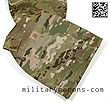 Back of front pouch |
 Front pouch pockets |
Both the front and rear plate pouches have single compartments for a plate; there is no seperate compartment for a plate backer or soft armour. Inside the compartment is an adjustment strap to adjust the height of the plate, if the plate is shorter than the compartment. The strap velcros inside the pocket and suspends the plate so that it's at the top of the pocket. The flap at the bottom is then secured with velcro.
Rear Plate Pouch - The rear plate pouch also has a flap, much like the front one, under which the cummerbunds attach with velcro. The flap has six columns and three rows of PALS webbing, and there are three more rows of PALS above it. Right at the top corners are the 2" common loops to which the rear plate carrier connects to the front one via the shoulder straps. A secondary rear flap wraps under the bottom of the plate carrier and secures on the back side of the pouch.
Cummerbund - The cummerbunds come in three sizes, differing only in length. The small cummerbund has 5 columns of PALS, the medium one has 7 columns, and the large has 10. The rear attachment feature is very low profile and adds barely any thickness in the rear. It consists of a 5" tall x 4" wide rectangle of black velcro one-wrap (a thin plastic sheet with hook one one side and loop on the other), with hook on the inside and loop on the outside. This is sewn to a 5" wide double-layer of heavy duty elastic which connects it to the rear of the cummerbund. The elastic allows for some 'give' and variability when donning the plate carrier over different clothing. At the front of the cummerbund is the velcro flap that secures it to the front plate pouch. The velcro flap wraps around and attaches to the velcro area on the front plate pouch under the front flap. The front flap then folds down and secures the cummerbund in place. A 3/4" tab on the front of the cummerbund helps get it unstuck from the front of the plate carrier when doffing the APC. The flap on the rear plate pouch is lined with hook velcro, while the plate pouch itself has a loop velcro field. The black rectangle of velcro one-wrap is placed on the plate pouch's velcro field then secured when the flap is pressed down. All girth adjustment is done at the rear, so it can take a couple of tries before the correct fit is achieved. The velcro one-wrap is very thin, so it doesn't add any bulk under the flap at all. The photo above of the front flap shows the desired overlap of the cummerbunds on the front plate pouch. Ideally, you want to adjust the cummerbunds so that the only the velcro area overlaps the front plate; not the PALS webbing part of the cummerbund, so that the front flap has full velcro engagement to keep it secured. The cummerbund has two compartments; the main one for a soft insert (I put a Level II insert from TACARM in it) and the outer one for accessories or a 6" x 6" plate. Velcro inside the outer pocket is used to position the plate forward or back. Offset 3/4" tabs aid in opening the pockets. Shoulders - The shoulder straps of the APC are unpadded for a very low profile. The 2" wide webbing strap sewn to the front plate pouch goes through the 2" common loop on the rear plate pouch, then secures down to itself via velcro. Ride-height adjustments are made with the shoulder straps. Mayflower's Armour Carrier Padded Shoulder Pieces also come with the APC and are also available seperately for use on other carriers if additional padding is needed. The pads are made of 500D Cordura with open mesh over reticulated foam padding. The mesh and foam do not hold any water, and do add comfort to the APC. The shoulder pads have two elastic loops through which the shoulder straps are threaded, then secured over the loops to keep the pads in place. The top of the pad is a flap that can open for easy routing of cables or hydration tubes.
Observations and notes - I started using the APC back in October last year. The first impression I got when handling the APC is the same for all other Mayflower products - it's very light. As mentioned previously, Mayflower has built a reputation around producing some of the lightest weight gear around. Also, it's all very economically priced, which is a plus in today's day and age, where getting value for your money is a major consideration when making a purchase. I've seen and examined most of the Mayflower gear, either at trade shows or owned by friends, but this is the first Mayflower item I've actually reviewed. Those of you who own Mayflower equipment are already familiar with with high quality of construction and the attention to little design details, like the angled corners on the front flap and small pull tab. All points of stress are bartacked, and everything is designed to create the lowest profile possible. I installed a medium CPC triple curve in-conjunction plate (10" x 11") in the front, and a large SAPI plate (10" x 13") in the rear, both with DBT L3A plate backers. As you can see from the photos below, the front-back profile of the APC is very slim. I'm a smaller guy (5' 7", 155 lbs) with a relatively short torso, so carriers that are too long tend to interfere with belt kit. The medium cummerbunds were too long for me, so the small cummerbunds worked better (I have a 43" chest, 32" waist). I wore the APC with the Crye non-ballistic low profile belt, and it rode high enough to provide adequate clearance between belt-mounted accessories in all positions. Items on the belt were a Safariland holster, EMDOM Gadget pouch, ATS small medical pouch, EMDOM Dump pouch, and two EMDOM IAP M4 pouches. I adjusted the shoulder straps so that the plates rode as high as possible, leaving just enough room to get my head through. The shoulder pads are actually quite effective, and do make a difference in comfort. They don't add hardly any bulk, so I they're a worthwhile addition to the rig.
|
 Worn over TAD Spectre hardshell |
 |
 |
 Worn over Arc'teryx Gryphon top |

|
In keeping with the low profile of the rig, I only installed a single row of M4 mag pouches on the front flap; in this instance the EMDOM IAP open-top pouches. If necessary, I could stuff another two or three mags down the kangaroo pouch in the front flap. A double pistol mag pouch was mounted on the right side cummerbund with four .45 single stack mags. Instead of a separate sling, I used the EMDOM URS strap anchored near the top of the rear plate carrier and routed over the right shoulder. Since the plate carrier is sewn 'flat' at the sides rather than 'box shaped', it 'smoothes out' the transition between the plate and the body, much like the SKD P.I.G. plate carrier. This allows for pretty good placement of the rifle stock on the outside of the plate, rather than having to hook it behind the plate. I was also quite surprised at how comfortable it was, given that it had no padding at all between the plates and my body. It helps that I was using triple curve plates, which are better contoured to the body. I had soft inserts in the cummerbunds, and with those installed, the cummerbunds were still very low profile. As expected, the body-hugging profle of the carrier enables unhindered motion and shooting from the positions I tried. Simple and efficient, yet full of features, the low profile APC is going to be a popular choice, I predict.
|
 |
 |
 |
 |
 |
 In the drizzle |
 Guarding the cooler |
ATTENTION! PLEASE DO NOT LINK DIRECTLY TO MY IMAGES
-
IT RESULTS IN MY BANDWIDTH ALLOCATIONS BEING EXCEEDED,
AND MY PAGES GO DOWN. THANKS!
/ . PLEASE
OBSERVE AND RESPECT OUR COPYRIGHT! . /
©opyright by MilitaryMorons.com. All Rights Reserved. Reproduction, Duplication,
Distribution Strictly Prohibited.
Unless mentioned otherwise, content and images are the
property of militarymorons.com and are not in the public domain.
They are not to be used without
permission. Please Contact
me for permission to use any images or content herein.



